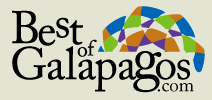Galapaguera Natural :: San Cristóbal Island

The hike from the beach to Media Luna cone is long, about 5 Km one-way and may be excessively hot since there is no circulation of wind. It is important to note that the walk takes a minimum 3 1/2 hours roundtrip; suggest to the group to carry enough fresh water.
It is a good site because you can see Galapagos tortoises in their natural environment.
There are goats in the interior and it is common to find their droppings along the way.
This site was opened for tourism in 1989. The park rangers make regular visits to control the goat population and to protect turtle nests.
San Cristobal Island has its own kind of tortoises, Geochelone elephantopus San Chatamensis, and although its population is small, there are some sufficiently close to the coast so that visitors can appreciate them in their natural environment. These tortoises have problems with competition for food with goats and donkeys. There are also feral cats, animal predators of juvenile tortoises.
Galapagos Islands Tours Galapagos Islands Cruises Galapagos Islands Information
![]()
San Cristobal Island also has some endemic species of animals of which are: the mockingbird, Nesomimus melanotis, lava lizard, Microlophus bivittatus (formerly Galapagos lizards were classified in the genus Tropidurus), a species of geckos, Phyllodactylus leei and tortoises. All these species can be observed in this place.
The beach is large and serves as a nesting area for sea turtles. In the months from January to May it is common to find traces of the females who have risen to the sand dunes to lay their eggs.
The wasps, Polistes versicolor versicolor, which were introduced to Floreana around 1988-89, have come to San Cristobal and in this site are especially abundant, more so during the rainy season. These wasps are drawn to bright colors and scented sunscreens. Inform visitors about this.
The vegetation here is abundant during the rainy season due to its dormancy during la garúa. There is much Galapagos milkweed, Palo santo trees and matazarno and many species of forbs and annual grasses. Immediately behind the landing beach, there are sporadic lagoons, which contribute to a large quantity of Sessuvium portulacastrum. In the time of rainfall, it is most likely that to visit the site, one has to go through mud.
![]()

